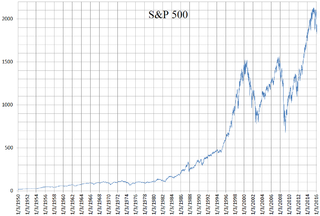Related Research Articles

NYSE American, formerly known as the American Stock Exchange (AMEX), and more recently as NYSE MKT, is an American stock exchange situated in New York City. AMEX was previously a mutual organization, owned by its members. Until 1953, it was known as the New York Curb Exchange.

The Standard and Poor's 500, or simply the S&P 500, is a stock market index tracking the stock performance of 500 of the largest companies listed on stock exchanges in the United States. It is one of the most commonly followed equity indices and includes approximately 80% of the total market capitalization of U.S. public companies, with an aggregate market cap of more than $43 trillion as of January 2024.
An exchange-traded fund (ETF) is a type of investment fund that is also an exchange-traded product, i.e., it is traded on stock exchanges. ETFs own financial assets such as stocks, bonds, currencies, debts, futures contracts, and/or commodities such as gold bars. Many ETFs provide some level of diversification compared to owning an individual stock.

The S&P Europe 350 Index is a stock index of European stocks.
The S&P Latin America 40 is a stock market index from Standard & Poor's. It tracks Latin American stocks.
The Russell Midcap Index is a stock market index that measures performance of the 800 smallest companies in the Russell 1000 Index.
iShares S&P 100 Index Fund is an exchange-traded fund of US stocks. The fund tracks the S&P 100 index.

iShares is a collection of exchange-traded funds (ETFs) managed by BlackRock, which acquired the brand and business from Barclays in 2009. The first iShares ETFs were known as World Equity Benchmark Shares (WEBS) but have since been rebranded.
SPDR funds are a family of exchange-traded funds (ETFs) traded in the United States, Europe, Mexico and Asia-Pacific and managed by State Street Global Advisors (SSGA). Informally, they are also known as Spyders or Spiders. SPDR is a trademark of Standard and Poor's Financial Services LLC, a subsidiary of S&P Global. The name is an acronym for the first member of the family, the Standard & Poor's Depositary Receipts, now the SPDR S&P 500 Trust ETF, which is designed to track the S&P 500 stock market index.
An inverse exchange-traded fund is an exchange-traded fund (ETF), traded on a public stock market, which is designed to perform as the inverse of whatever index or benchmark it is designed to track. These funds work by using short selling, trading derivatives such as futures contracts, and other leveraged investment techniques.
The S&P/ASX 300, or simply, ASX 300, is a stock market index of Australian stocks listed on the Australian Securities Exchange (ASX). The index is market-capitalisation weighted, meaning each company included is in proportion to the indexes total market value, and float-adjusted, meaning the index only considers shares available to public investors.
The S&P SmallCap 600 Index is a stock market index established by S&P Global Ratings. It covers roughly the small-cap range of American stocks, using a capitalization-weighted index.

In finance, a stock index, or stock market index, is an index that measures the performance of a stock market, or of a subset of a stock market. It helps investors compare current stock price levels with past prices to calculate market performance.

SPDR Gold Shares is part of the SPDR family of exchange-traded funds (ETFs) managed and marketed by State Street Global Advisors. For a few years, the fund was the second-largest exchange-traded fund in the world, and it was briefly the largest. As of the close of 2014, it dropped out of the top ten.

Invesco PowerShares is an American boutique investment management firm based in suburban Chicago. The firm manages a family of exchange-traded funds or ETFs. The company has been part of Invesco, which markets the PowerShares product, since 2006.
The SPDR S&P 500 ETF Trust is an exchange-traded fund which trades on the NYSE Arca under the symbol SPY. The ETF is designed to track the S&P 500 index by holding a portfolio comprising all 500 companies on the index. It is a part of the SPDR family of ETFs and is managed by State Street Global Advisors. The fund is the largest and oldest ETF in the USA. Legally, the fund is set up as a unit investment trust. It has a net expense ratio of 0.0945%, its CUSIP is 78462F103, and its ISIN is US78462F1030.
The Barron's 400 Index or B400 is a stock market index of 400 public companies in the United States, as selected by editors and associates of Barron's magazine. Established in 2007, the Barron's 400 has tended to outperform certain other major indexes at least through the first half of 2013.
References
- 1 2 "S&P 400 Overview". S&P/Dow Jones Indices LLC. Retrieved January 20, 2013.
- ↑ "S&P 400® Factsheet" (PDF). S&P Global. p. 5.
- ↑ "S&P U.S. Indices Methodology" (PDF). Standard & Poor's. Retrieved 16 December 2017.
- 1 2 "S&P Dow Jones Indices Announces Update to S&P Composite 1500 Market Cap Guidelines" (PDF). S&P Global. January 2, 2025. Retrieved January 7, 2025.
- ↑ MDY - SPDR S&P MidCap 400 ETF State Street Global Advisors (SSgA)
- ↑ "Vanguard S&P Mid-Cap 400 ETF".
- ↑ iShares Core S&P Mid-Cap ETF (IJH): Overview iShares
- ↑ Mid-Cap ETFs Find a Sweet Spot Yahoo Finance
- ↑ S&P MidCap 400 Factsheet
- ↑ S&P MidCap 400® | S&P Dow Jones Indices